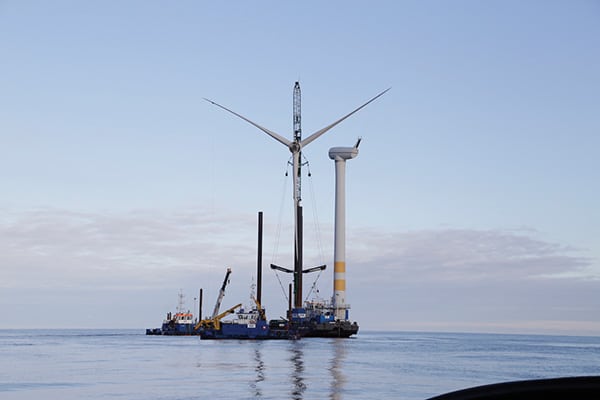Vattenfall Completes World's First Decommissioning of an Offshore Wind Farm
Vattenfall has dismantled five offshore wind turbines—with a total capacity of 10 MW—at the Yttre Stengrund wind farm in Kalmar Sound, Sweden. The month-long decommissioning project was the first in the world for an offshore wind farm, but more projects will soon follow as early turbines reach the end of their two-decade lifetimes.
The Yttre Stengrund wind farm had only been in operation since 2001, said Vattenfall, which bought the farm in 2006. The Swedish utility chose to dismantle the entire wind farm rather than replace the turbines with more modern ones for “financial and technical” reasons, it said. “The turbines that were installed at Yttre Stengrund were an early model and only about 50 of them in total were actually produced. The difficulty of getting hold of spare parts and the huge cost involved in upgrading the turbines and gearboxes meant that it wasn’t financially viable to replace the turbines,” explained Maria Hassel, who managed the project to dismantle the facility for Vattenfall.
“Yes, it may seem a bit of a contradiction in terms but Yttre Stengrund was one of our first wind farms and we’ve learnt a lot over the almost 10 years that we’ve been operating it,” she said. “That knowledge, combined with the prohibitive cost and technical difficulty of replacing the turbines, made this a relatively straightforward decision. We have locations with better wind conditions in other parts of the country where we can build new wind power and take with us the knowledge we’ve gained from Yttre Stengrund.”
The decommissioning process, essentially the reverse of installation, involved the removal and lowering of rotor blades and turbine housings by Swedish firm Svensk Sjöentreprenad (Figure 2). The firm also dismantled the towers and leveled the concrete foundations with the seabed. “There were no major issues with the work itself but the operation was delayed by a month due to bad weather, which was a major risk throughout the dismantling process,” Vattenfall said. The utility will now “restore the site in such a way that any trace of the former wind farm will be negligible.” It will also work to remove underwater cables this summer. A time-lapse video of the dismantling project can be viewed on YouTube.
Later this year, Danish utility DONG Energy will also move to decommission a 4.95-MW wind power facility off the island of Lolland—at the site of the world’s first offshore wind farm. DONG Energy put up the 11 turbines (each 450 kW) at Vindeby wind farm in 1991, about 2.5 kilometers off the Danish coast.
According to the European Wind Energy Association (EWEA), the growth of the offshore wind power sector was irregular until 2001, with just a handful of small, near-shore projects (a total capacity of 86 MW) coming online in Dutch and Danish waters. The world’s first “utility-scale” offshore wind farm—the Middelgrunden project in Danish waters—came online in 2001 featuring 20 turbines for a total capacity of 40 MW. That same year, Vattenfall and DONG Energy grid-connected seven GE 1.5-MW turbines offshore Utgrunden in Sweden. EWEA notes that the world’s offshore wind capacity was concentrated in Europe until 2010, when China inaugurated the Donghai Bridge Wind Farm.
But even though just a handful of offshore wind farms have been operating for half their 20- to 25-year design lives, offshore wind farm owners should be wary of and prepare for what could be exorbitant decommissioning costs, said consulting group DNV GL in a March 2015 white paper. “The techniques and logistics for the decommissioning of offshore wind farms are very site-specific, leading to a wide range of projected costs,” it said. Costs can vary on project characteristics, as well as the scope of decommissioning—whether piles and cables will be removed or left in-situ, for example—and site conditions. Then, as with construction of offshore wind farms, they will also be very dependent on the vessels selected and optimization of marine logistics.
“When all aspects of the decommissioning phase are considered, costs may approach [€1 million] per turbine unit and in particular cases the costs are estimated to be much higher,” warned DNV GL. It is important to capture all the contributions in a cost model and to recognize those that have the strongest influence, said the firm. “Furthermore, by considering decommissioning costs early in the life of a project, it is possible to introduce measures to reduce these costs.”
—Sonal Patel, associate editor
